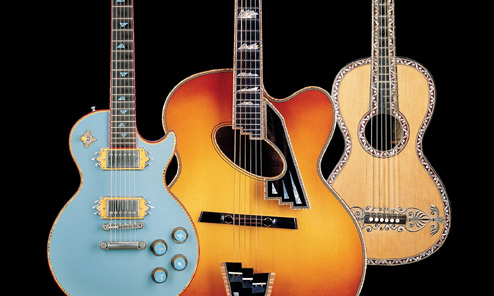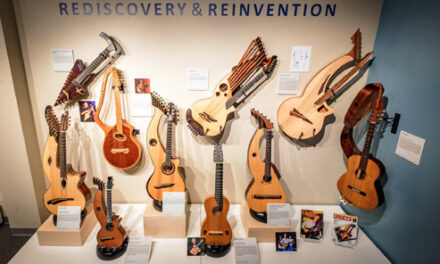At the AMIS conference last May, some of us were humorously bemoaning the old “it’s on the Internet, so it must be true” paradigm (yes, there was much Wikipedia-bashing during the many professional papers). One, however, reminded the group that even among those of the public that take the web with a heavy dose of salt, many still put their faith in published hardcopy material “It’s in a book, so it must be accurate.” Again we chortled – as all have seen much misinformation printed in all sorts of seemingly scholarly works by various “experts.” It’s why I’m happy to publish my own findings on the web; because, A) it’s really no less “true” than in a magazine, periodical or book – and, B) if I make a mistake (not seldom enough) or later find new information (invariably), I can perpetually update the topic.
But back to books. I’ve already critiqued various “harp guitar” entries in recent books on this blog and will continue to do so (as other researchers continue to help correct information on my own site). Since printed material is “written in stone,” I always find it unfortunate that the authors/editors were not able to discover the latest information (for example, on Harpguitars.net) that could possibly have helped their entries and facts, if not perspective. I’m really only a “Google away” and almost impossible to miss. So, future Guitar and Plucked String authors: feel free to use the resources I continue to painstakingly archive on this site, or even better, consult with me on these esoteric topics and instruments. Getting better information and accurate publicity out there is part of my “crusade.”
So much so that anytime I’m asked for photos for inclusion in books or other media projects (increasingly), I always offer proofreading or editorial help with harp guitars and other unusual instruments. I’m rarely taken up on it, however. My policy is generally: free photos and use, just get the captions right, and send me a copy of the book when done (just did this again with Randy Osborne at FFSI, in fact). I’ve recently decided to become a bit stricter, however, and insist on editorial input where my photos are to be referenced or discussed. Nothing “controlling” mind you, just simple fact-checking (although perspective – admittedly a personal bias – is something I wish I had more chance to advise on, whether regarding historical aspects or activities of the modern harp guitar community, which inevitably comes up when broached regarding articles, books or film projects).
Case in point: I was recently asked for photos of several Knutsen instruments for an upcoming guitar book from a major publisher (yes, we can never have too many guitar books!). I was thrilled (if a bit surprised) that, not only harp guitars but 4 or 5 Knutsen instruments were to be shown and discussed in a book concerning “a history of the best guitars and amps, including Gibson, Fender, Marshall, etc.” You know I never miss an opportunity to promote and advertise these instruments – what could be better? They even offered a not insignificant payment for photos. I ultimately declined to help, which put me in the position of feeling like a pompous ass (no jokes, please!), even though I feel no guilt about my stance.
Here’s my basic issue (again, future requestors of images or information, take note) – and you can judge for yourself if I was too much of a jerk…
Promotion and visibility are great, but I worry that having my photos appear in a publication might naturally imply a “collaboration” or, at minimum, an “approval” of the work in question. That speaks to my reputation – beyond the general goals and manifesto of the Harp Guitar Foundation which I head. Again, I simply want to help ensure that the information is reasonable and accurate. In this recent case, after initial overtures, when the author and scope (focus) of the book were not divulged, I was concerned. Finally, with about a week or two deadline, I was contacted again, and I asked again for information. Soon the author called. He was a very nice man, whom I had unfortunately never heard of. Regarding his writing and research credentials, he is a full-time professional guitar player of 20 years experience (“with contacts,” ergo a book deal). Prying further, I learned that his sole source of information on Knutsen seemed to be Jonathan Kellerman’s book of his collection. Nothing wrong with Jon’s work (and he of course researched his Knutsen instruments via me and the Archives), but it’s a “guitar stories” book with a few random Knutsen instruments presented in “entertainment” style (even more so than my own attempts; he is a bestselling author, after all). The author had just finally found the Knutsen Archives a week prior (but still unaware of the Noe/Most book). He humbly admitted he was no expert and agreed to email me drafts of the applicable text for review, which – who knows? – could have proven to be professional, accurate and wonderful. Alas, instead I only got a note from his editor, assuring me that any Knutsen information would be “positive.” Well, I never really doubted that, that’s not the point. With no frame of reference, and only their inaccurately-titled list of instrument names to go on, I decided to pass.
I truly hope I can say positive things about the book when it comes out (if it’s great, I will feel like a dope!), but folks, a little communication and collaboration upfront is all I ask.
Voting:
A) Hey, you’re “the pope,” why aren’t they availing themselves of your free expertise?
B) Hey, you are a pompous ass!
C) (Your comments here)






Oh, this is sooooooo tempting. But I think the bottom line is that your approach is the best one.
Keep keeping em honest, or keeping trying to, at any rate.
Best,
sb
I’ve spent most of my professional career in major newspapers as a photojournalist. Later as a freelance photographer/digital illustrator I dealt with more publishing/art director types than I ever want to remember. Your approach was what I would call “media savvy”. Its a wild free for all out there with no rules and even less accountability. Guarding your personal/professional boundaries and ethics is a prudent approach. “Give ’em Hell Pope!”
-jay
Thumbs up, Pope!
c) Your points are perfectly valid through and through, and surely the publisher sees that – nothing at least in your report suggests otherwise. Let’s hope its a good book, because, as you already stated, the world cannot have too much guitar literature.
c)Defend your rights and your amazing studies of harp guitars!
Benoit